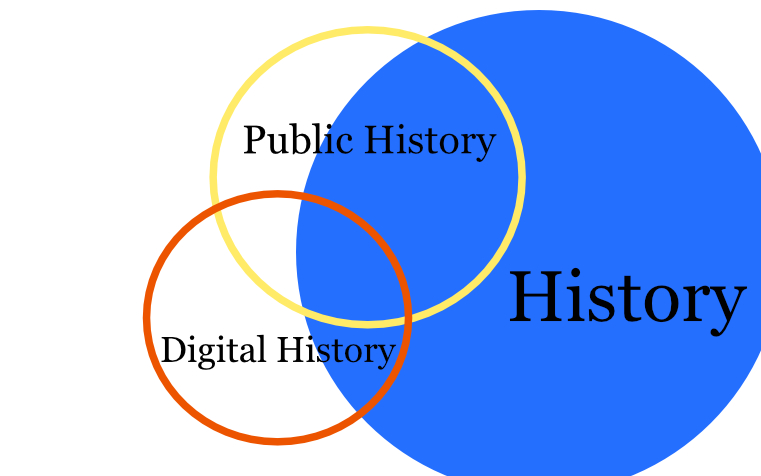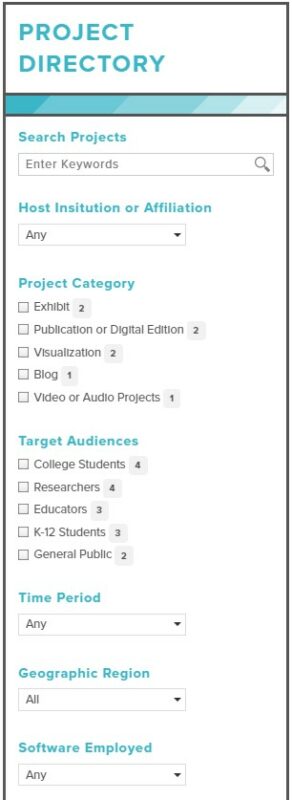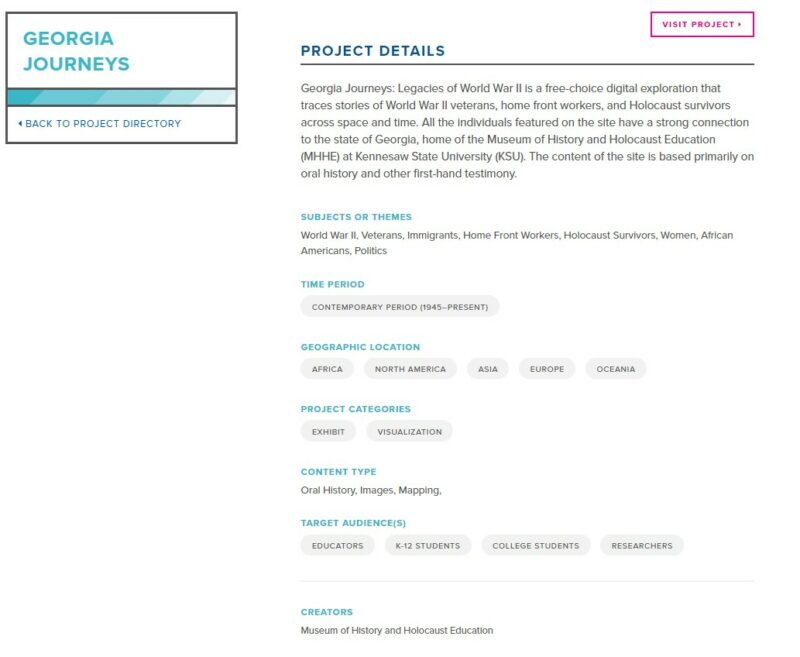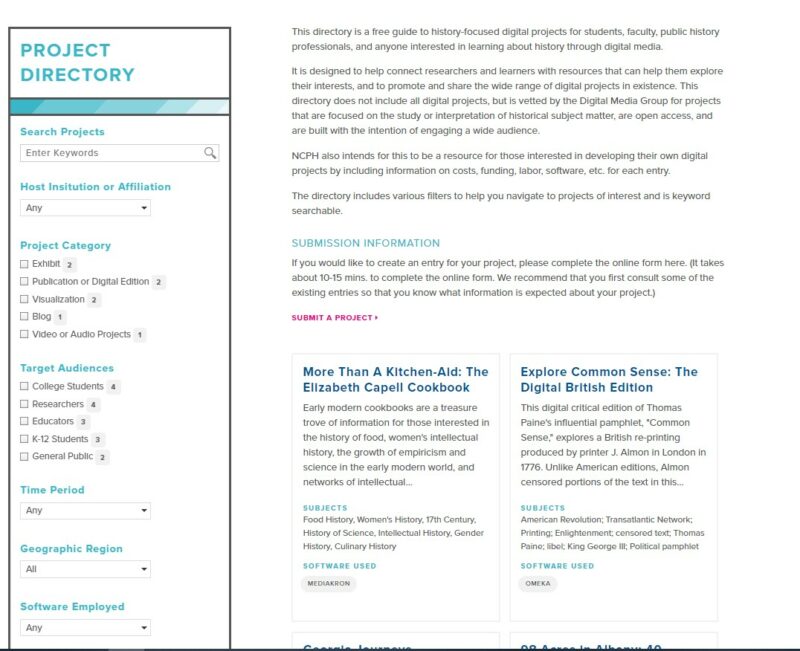New resource launched: the NCPH Digital Projects Directory
19 March 2021 – Kate Johnson and Marie Pellissier

Venn diagram showing the overlapping categories that create digital public history. Image credit: Not Even Past
Digital Projects Directory
NCPH’s Digital Media Group (DMG) is excited to announce the launch of the Digital Projects Directory. The Directory is a free guide to history-focused digital projects for students, faculty, public history professionals, and anyone interested in learning about history through digital media. It is designed to help connect researchers and learners with resources that can help them explore their interests and to promote and share the wide range of digital projects in existence. This directory does not include all digital projects, but is vetted by members of the DMG for projects that are focused on the study or interpretation of historical subject matter, are open access, and are built with the intention of engaging a wide audience. The directory is populated by user submissions, so please consider submitting your digital projects and sharing this resource among your colleagues and networks.
Origins of the project
The Digital Projects Directory emerged from conversations in the working group “Facilitating Digital Access to Primary Sources,” which we chaired at the 2018 NCPH conference in Las Vegas. Within that group, we talked about best practices for digital projects designed to increase access to primary sources. We discussed how digital humanities projects are not “public” projects merely by virtue of being online, and that intentional design and attention to engagement are necessary for true digital public history. After a lot of fruitful discussions, participants agreed that a resource to collect and promote digital public history projects would be useful for public historians, students, teachers, and anyone interested in digital public history. Reflecting on our own experiences with creating digital history projects, we agreed that a project directory that could be sorted by type of project, budget, software used, and other behind-the-scenes criteria would also be a useful tool for these audiences.
Research on other Resources
Inspired by these conversations, we formed a sub-committee of the DMG and immediately started looking at what resources already existed. We found a few collections, like the Roy Rosenzweig Center for History and New Media, which offers a directory of projects directly supported by their organization. The National Humanities Alliance has a similar directory, limited to projects created by academic institutions. Other options we found were often narrowly focused in scope. For example, the Colored Conventions Project, a collaborative digital humanities project, created a simple list of digital humanities projects and resources focused on Black history. An online, open access journal, Reviews in Digital Humanities, showcases projects alongside peer reviews, but does not provide the kind of searchability we wanted for our directory, nor does it focus specifically on public history projects.
Goals for the Directory
We realized we could design our directory to offer a unique resource of tremendous value for historians, researchers, and especially for educators and students. Teachers looking for interactive ways to engage their students could go to the directory and find projects related to their curriculum. Historians looking for methods to pull new interpretations from historical documents could connect with textual analysis projects. Students interested in creating digital projects to aid in their learning would be able to find examples of work and gain understanding of the funding and labor behind the projects. We set four goals for the directory:
- Create a searchable, categorized directory of digital public history projects, to be hosted on the NCPH website
- Connect scholars with and make them aware of projects related to their fields of interest
- Provide examples of digital projects for those seeking to create their own project
- Create the directory to be populated by users, rather than DMG members
Designing the database
Using NCPH’s Guide to Public History Programs and Consultants Directory as the basis for our directory’s framework, we thought about how to solicit and catalog projects. We divided the submission form into three parts. The first section contains open-ended, basic information, such as the project title, creators, a stable link for the project, and contact information. The second section consists of controlled answers to be used in the directory filters, categories like time period, geographic region, software, cost category, etc.

Screenshot of the “Digital Projects Directory”
The third section was the trickiest, as we wanted projects to be able to apply identifiers that would help directory users discover and connect with projects based on their interests. Given the wide range of potential identifiers a submission might include, we decided to leave them open-ended to allow flexibility, but recommended using Library of Congress authority headings for consistency to make it easier for users searching by keyword.
Making the project a reality
Once we had an outline for the directory’s framework, we drafted a proposal with feedback from the whole DMG and went before NCPH’s board in August 2020. Because we were able to leverage existing templates already on NCPH’s website, the development costs from the web designer were estimated at $1,800-2,400, for which the board approved funding. By mid-fall, our web designer, Kyle Larkin of Extra Small Design, had a prototype ready, which the full DMG tested to ensure a smooth user experience. After making final adjustments, the website went live in February 2021. DMG members solicited project submissions from their personal networks to help initially populate the directory before the official launch on March 13, 2021, during NCPH’s virtual conference.
How to use the Directory
The Digital Projects Directory is designed to serve users with a variety of needs. Users can browse entries in the directory directly from the homepage or they can narrow their results using a variety of filters. Each project has a display card which includes a snapshot of the project description and subject tags.

Screenshot of the display card for “Georgia Journeys: Legacies of World War II” in the “Digital Projects Directory.”
For users who are interested in using the Directory as a resource to launch their own projects, filters for software, budget, and target audience offer a way to find example projects that fit within specific parameters. For example, a graduate student working with a minimal budget can filter to see all the projects in the directory completed with a budget of less than $500, while a museum professional applying for grant funding could filter to see projects completed on a similar budget to provide comparative information for a grant application.
Reviewing submissions
The Directory is designed to allow individuals to submit their own digital projects or to submit on behalf of an institution. Clicking “Submit a Project” brings the user to the submission page, where they are required to provide a title, permalink, description, and contact email (for internal use only). The form asks for the budget, categorization, software used, keywords, and other metadata to help the entry show up in the Directory’s various filters. The entire form takes no more than 10-15 minutes to complete.
Once the form has been completed, members of the Digital Media Group review each entry to ensure that it meets the following four criteria:
- Does this project focus on the analysis, interpretation, or presentation of historical subject matter?
- Does this project leverage digital tools or resources (i.e., interactives, audio/visuals, mapping, graphing, textual analysis, crowd-source transcription software, etc.)?
- Does this project target a public audience (i.e., students, researchers (academic and non-academic), educators, museum audiences, etc.)?
- Is this project open access? That is, is it behind a paywall? Qualifying projects may not be behind paywalls of any kind.
Once projects are approved by DMG members, the Directory homepage updates so that the most recently approved entries appear at the top, so users will find new digital projects to explore each time they return to the Directory.

Screenshot of the NCPH “Digital Projects Directory”
Call for projects
In order for the Directory to fulfill its purpose, we need submissions! With your help, we can make this a wonderful resource for public historians, students, teachers, and anyone interested in digital history projects. If you have a project you’d like to submit, please consider doing so today—and share this resource far and wide! It will live on NCPH’s website under the “Publications & Resources” tab, under “Publications” and “Other NCPH Publications,” as well as under “For Public History Educators,” “Graduate Student Education,” and “Undergraduate Education.” We’d also appreciate any and all feedback about the directory to ensure it’s serving your needs. Please consider leaving us a comment at the end of this blog post!
~Marie Pellissier is a PhD candidate at William & Mary. She works on food and memory in early America.
~Kate Johnson works in Archives and Special Collections at the University of Northern Colorado and is a member of NCPH’s Digital Media Group.




Great resource. Thank you.